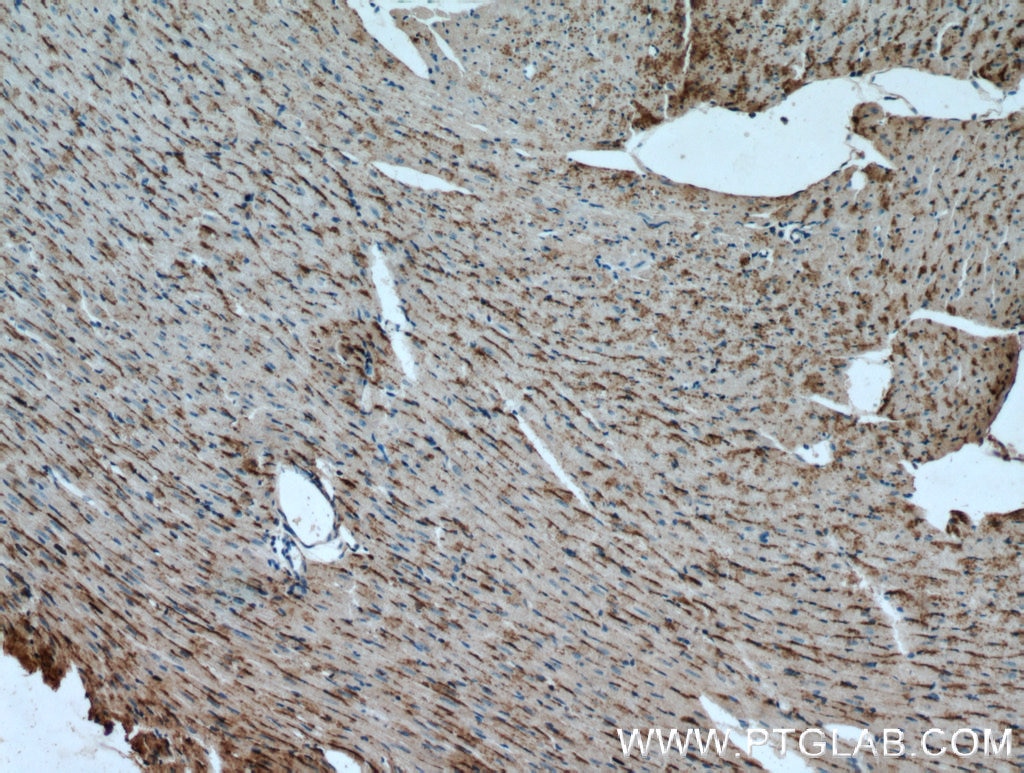- Phare
- Validé par KD/KO
Anticorps Polyclonal de lapin anti-Cathepsin F
Cathepsin F Polyclonal Antibody for IHC, ELISA
Hôte / Isotype
Lapin / IgG
Réactivité testée
Humain, rat, souris
Applications
WB, IHC, ELISA
Conjugaison
Non conjugué
N° de cat : 11055-1-AP
Synonymes
Galerie de données de validation
Applications testées
| Résultats positifs en IHC | tissu de cancer de la prostate humain, tissu cardiaque de souris, tissu cardiaque humain, tissu de cancer de l'estomac humain, tissu hépatique de souris il est suggéré de démasquer l'antigène avec un tampon de TE buffer pH 9.0; (*) À défaut, 'le démasquage de l'antigène peut être 'effectué avec un tampon citrate pH 6,0. |
Dilution recommandée
| Application | Dilution |
|---|---|
| Immunohistochimie (IHC) | IHC : 1:20-1:200 |
| It is recommended that this reagent should be titrated in each testing system to obtain optimal results. | |
| Sample-dependent, check data in validation data gallery | |
Applications publiées
| KD/KO | See 2 publications below |
| WB | See 1 publications below |
| IHC | See 3 publications below |
Informations sur le produit
11055-1-AP cible Cathepsin F dans les applications de WB, IHC, ELISA et montre une réactivité avec des échantillons Humain, rat, souris
| Réactivité | Humain, rat, souris |
| Réactivité citée | rat, Humain |
| Hôte / Isotype | Lapin / IgG |
| Clonalité | Polyclonal |
| Type | Anticorps |
| Immunogène | Cathepsin F Protéine recombinante Ag1521 |
| Nom complet | cathepsin F |
| Masse moléculaire calculée | 53 kDa and 34 kDa |
| Numéro d’acquisition GenBank | BC011682 |
| Symbole du gène | Cathepsin F |
| Identification du gène (NCBI) | 8722 |
| Conjugaison | Non conjugué |
| Forme | Liquide |
| Méthode de purification | Purification par affinité contre l'antigène |
| Tampon de stockage | PBS avec azoture de sodium à 0,02 % et glycérol à 50 % pH 7,3 |
| Conditions de stockage | Stocker à -20°C. Stable pendant un an après l'expédition. L'aliquotage n'est pas nécessaire pour le stockage à -20oC Les 20ul contiennent 0,1% de BSA. |
Informations générales
CTSF(Cathepsin F) is a member of the papain family of cysteine proteases. These enzymes represent a major component of the lysosomal proteolytic system. They are synthesized as inactive precursors consisting of a signal sequence, a propeptide, and a catalytically active mature region. Cathepsins are routed to the endosomal/lysosomal compartment via the mannose 6-phosphate receptor pathway. The deduced 484-amino acid cathepsin F protein has a signal sequence and potential glycosylation sites.
Protocole
| Product Specific Protocols | |
|---|---|
| IHC protocol for Cathepsin F antibody 11055-1-AP | Download protocol |
| Standard Protocols | |
|---|---|
| Click here to view our Standard Protocols |
Publications
| Species | Application | Title |
|---|---|---|
Stem Cell Res Ther Adipose-derived stem cells alleviate radiation-induced dermatitis by suppressing apoptosis and downregulating cathepsin F expression.
| ||
Brain Res Bull Adenovirus-driven overexpression of proteinases in organ-cultured normal human corneas leads to diabetic-like changes. | ||
Proc Natl Acad Sci U S A A small-molecule drug inhibits autophagy gene expression through the central regulator TFEB | ||
Oncol Res Cathepsin F Knockdown Induces Proliferation and Inhibits Apoptosis in Gastric Cancer Cells
|










